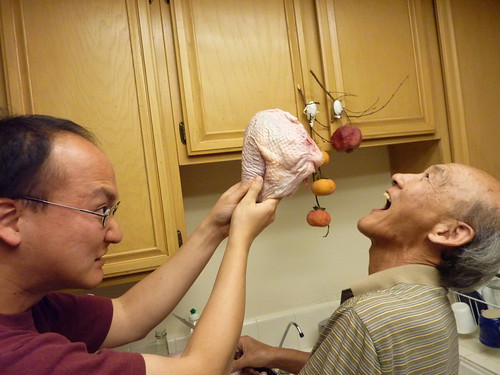Life, on the Line is the remarkable story of Grant Achatz, chef/owner of Alinea in Chicago and widely acknowledged as one of the best chefs in the world. It’s a compelling play-by-play of the commitment, vision, and tenacity required to be the best. It’s also a beautiful tale of the mentorship (from Thomas Keller), partnership (with Nick Kokonas, co-owner of Alinea and coauthor of the book), and friendship (with Keller, Kokonas, and many others) that kept Achatz on track. There’s even a bad guy (Charlie Trotter).
Oh yeah, and then there’s the tongue cancer.
In 2007, barely into his 30s and shortly after reaching the pinnacle of the restaurant world, Achatz was diagnosed with Stage IV tongue cancer. The prognosis was horrible. Most people with this form of cancer lose their tongue, half their face, and part of their neck. Only 50% survive after surgery. Achatz didn’t see the point of living this way and was ready to give up. Then he got lucky and found his way into a clinical trial at Northwestern. He managed to survive, tongue and face intact, but he also lost his sense of taste for many months (a story well-documented by the New Yorker in 2008).
The book was a page-turner in so many ways, and it’s a great read for anyone into food, high-performance collaboration, design, or new media. It’s a well-told story overall, but in my current state of exploration around impact, there was one brief, throwaway line in the Epilogue that caught my attention:
Alinea is a small business run by a small group of people.
After reading all of the great things that Achatz accomplished, and knowing the broader context for his story, it was remarkable to see his restaurant described this way. I was somewhat incredulous, so I ran the numbers using hints from the book. Sixty covers a night at an average of $200 a cover, five nights a week, 51 weeks a year for the flagship Alinea (not counting his other two restaurants, book royalties, appearances, etc.) — about $3 million in annual revenue. Given the downtown Chicago real estate, the cost of sourcing countless top-quality, often obscure ingredients, and 60+ salaries, it’s a miracle that they make any money at all.
So yes, it seems quite accurate to call Alinea a small business. Somehow, I found this comforting and inspiring. I want to live comfortably and joyfully, and I want to make an impact. I think it’s easy to get into the mindset that you have to create some sort of global, financial monolith in order to achieve that kind of success, but I don’t think that’s right. I like small business. I’ve started two of them, and I’d like to be part of another one. You can do that and make an impact.
Achatz’s story offers somewhat of a playbook for doing that. (It’s not the perfect template. Work-life balance is clearly not important to him. Maybe that’s an inevitable trade-off, but I haven’t quite succumbed to that belief yet.) I think the basic formula is simple, reminiscent of Steve Martin’s career advice to young comics:
Be so good they can’t ignore you.
There are lots of things that have to happen in order to scale your impact, but it starts with constantly working on your craft, constantly striving to be the very best you can be. Do that, be a good person, and all that other stuff will eventually fall into place. This book was an excellent reminder of that.







